The Aerial Ladder Trucks Market is estimated to be valued at USD 4.3 billion in 2025 and is projected to reach USD 6.6 billion by 2035, registering a compound annual growth rate (CAGR) of 4.5% over the forecast period. Growth is defined by steady procurement cycles, modernization of municipal fleets, and stronger compliance with international fire safety standards. Between 2025 and 2028, values climb from USD 4.3 billion to USD 4.9 billion, driven by demand in urban fire brigades and emerging economies that prioritize vertical safety solutions. Investment during this phase is supported by rising infrastructure projects and the need for aerial platforms capable of addressing mid to high-rise buildings.
From 2029 to 2032, the market shows consistent progress as revenues move from USD 5.1 billion to USD 5.8 billion, reflecting structured replacement programs, regulatory mandates, and integration of digital monitoring systems. Growth becomes more predictable, with incremental additions shaped by safety-driven procurement policies. The period from 2033 to 2035 highlights maturity, with values increasing from USD 6.1 billion to USD 6.6 billion. The YoY growth curve demonstrates an initial slowdown after 2025, followed by stabilization around mid-level growth rates. This indicates that adoption has shifted from early expansion toward sustained replacement and service contracts.
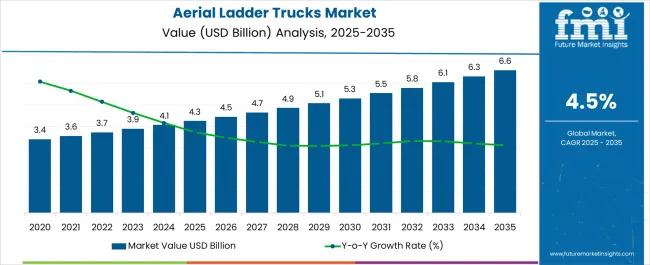
| Metric | Value |
|---|---|
| Aerial Ladder Trucks Market Estimated Value in (2025 E) | USD 4.3 billion |
| Aerial Ladder Trucks Market Forecast Value in (2035 F) | USD 6.6 billion |
| Forecast CAGR (2025 to 2035) | 4.5% |
The aerial ladder trucks market is expanding steadily as fire departments and emergency response agencies continue to modernize fleets with high reach and versatile equipment. Urban verticalization, complex building architectures, and increased fire risk in high density areas have driven the need for aerial solutions that offer both access and water discharge capabilities.
Advancements in hydraulic systems, stabilization technology, and lightweight high strength materials have enhanced the operational efficiency and safety of these vehicles. Growing municipal investments in disaster preparedness and stringent safety compliance standards are also contributing to market growth.
The long term outlook remains favorable as authorities prioritize faster response times and improved equipment reach to tackle fire hazards in diverse terrains and structural environments.
The aerial ladder trucks market is segmented by product, height, application, end-user industry, and geographic regions. By product, the aerial ladder trucks market is segmented into tower ladders, turntable ladders, hydraulic platforms, and tiller trucks. In terms of height, the aerial ladder truck market is classified into Low-Height (up to 50 meters), Mid-Height (50–100 meters), and High-Height (100+ meters). Based on application, the aerial ladder trucks market is segmented into firefighting, Non-fire rescue operations, and Others. By end-user industry, the aerial ladder trucks market is segmented into fire departments, municipal corporations, Industrial plants, Airports, and Others. Regionally, the aerial ladder trucks industry is classified into North America, Latin America, Western Europe, Eastern Europe, Balkan & Baltic Countries, Russia & Belarus, Central Asia, East Asia, South Asia & Pacific, and the Middle East & Africa.

The tower ladder product segment is expected to account for 38.60% of the total market revenue by 2025, emerging as the leading product type. Its dominance is driven by its ability to deliver both vertical and horizontal reach, allowing fire crews to operate effectively at varying heights and angles.
The inclusion of telescopic booms and elevated platforms ensures safe rescue operations and firefighting access in mid to high rise structures. Additionally, the ability of tower ladders to support high capacity water flow and crew deployment contributes to their selection over conventional ladder systems.
The segment continues to lead due to its adaptability and operational superiority in complex emergency scenarios.
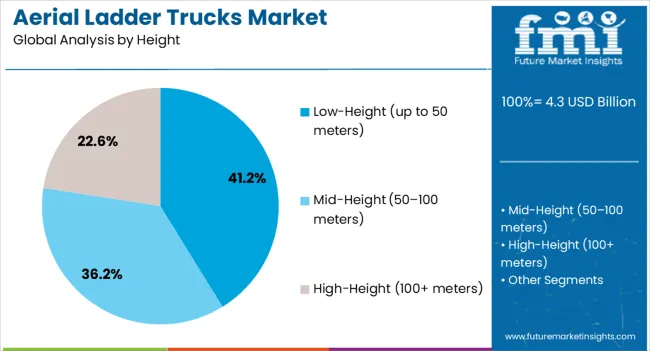
The low height segment, defined by operational reach up to 50 meters, is projected to represent 41.20% of market revenue by 2025, making it the largest height category. This preference stems from the fact that most urban and suburban structures fall within this height range, allowing efficient and cost effective deployment.
Vehicles in this category provide faster setup, improved maneuverability, and reduced maintenance compared to higher reach models. Their compatibility with narrow streets and congested environments further supports their widespread use by municipal and regional fire services.
The segment's practicality and budget-friendly nature have positioned it as the most preferred height category in aerial ladder truck applications.

The fire fighting application segment is forecasted to account for 54.70% of the total market share by 2025, firmly establishing it as the dominant application. This growth is primarily driven by the increasing need for rapid access to high elevation fire zones in commercial, industrial, and residential sectors.
Fire departments are prioritizing aerial trucks equipped with multi-function capabilities that combine reach, rescue, and water discharge in a single platform. Their role in emergency operations, especially in high-rise fires and complex firegrounds, has made them an essential component of urban fire response infrastructure.
As fire risk mitigation becomes more critical with urban expansion, this application is set to maintain its lead in the aerial ladder trucks market.
The aerial ladder truck market is growing due to rising demand for advanced fire safety solutions, regulatory requirements, and fleet modernization. The focus on emergency response efficiency is driving further adoption of these specialized vehicles for effective fire and rescue operations.
The aerial ladder trucks market is experiencing growth due to the increasing need for advanced firefighting equipment in urban areas. As high-rise buildings and complex infrastructure grow, the demand for specialized rescue and fire suppression tools, such as aerial ladder trucks, is rising. These trucks are essential for accessing upper floors of tall buildings, providing a critical role in saving lives and mitigating property damage. Municipalities and fire departments are prioritizing the acquisition of such equipment to ensure effective responses to emergencies in densely populated regions. The growing emphasis on fire safety, coupled with rising fire incidents in urban areas, is driving the expansion of the aerial ladder truck market.
Stricter fire safety regulations and building codes are pushing the need for more sophisticated firefighting tools. Regulatory requirements, especially those related to high-rise buildings and large industrial sites, are influencing fire departments to upgrade their fleets with advanced aerial ladder trucks. These regulations demand greater accessibility for fire trucks to reach all parts of buildings during emergencies. This, in turn, increases the demand for longer ladders, improved stability features, and advanced capabilities in firefighting trucks. The regulatory environment ensures that fire departments continue investing in equipment that meets these compliance standards, driving the demand for specialized vehicles like aerial ladder trucks.
The ongoing modernization of firefighting fleets is a significant factor in the growth of the aerial ladder truck market. Fire departments are increasingly replacing outdated vehicles with newer models that offer enhanced performance, safety, and efficiency. These modern aerial ladder trucks are designed to offer better reach, more stability, and the capability to operate in diverse weather conditions. This modernization trend is being driven by the need for enhanced firefighting capabilities and improved safety features. As fire departments aim to meet higher operational standards and improve response times, they are turning to advanced aerial ladder trucks, leading to market growth and innovation in vehicle design.
Aerial ladder trucks are being integrated into firefighting strategies that focus on improving response times and operational efficiency. Firefighters rely on these trucks to quickly reach higher floors of buildings, saving crucial time during rescues. As firefighting strategies evolve, there is a growing emphasis on ensuring that emergency response teams have access to the best equipment to optimize their operations. The ability to deploy aerial ladder trucks swiftly and efficiently in emergency situations ensures better preparedness and reduces the risk of fatalities during fire-related incidents. This efficiency-driven demand is shaping the aerial ladder truck market, encouraging fire departments to enhance their capabilities through new vehicle investments.
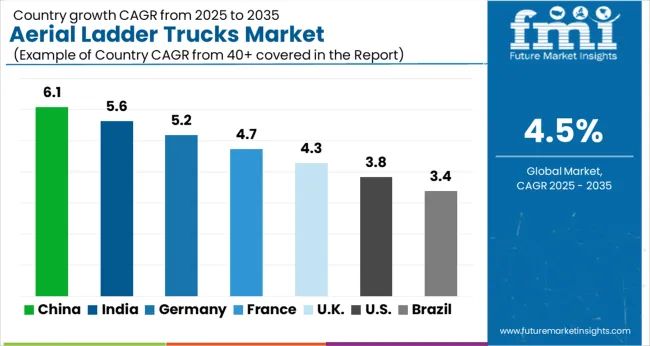
| Country | CAGR |
|---|---|
| China | 6.1% |
| India | 5.6% |
| Germany | 5.2% |
| France | 4.7% |
| UK | 4.3% |
| USA | 3.8% |
| Brazil | 3.4% |
The aerial ladder trucks market is projected to grow globally at a CAGR of 4.5% from 2025 to 2035, driven by increasing urbanization, rising fire safety requirements, and greater demand for advanced rescue vehicles. China leads with a CAGR of 6.1%, supported by large-scale infrastructure projects, growing urban populations, and government initiatives to enhance fire safety and emergency services. India follows closely with a 5.6% CAGR, benefiting from an expanding industrial base, infrastructure development, and increasing fire safety standards. France records 4.7%, influenced by stringent safety regulations and increasing investments in firefighting technologies. The UK grows at 4.3%, supported by the need for more effective urban firefighting solutions and rising government spending on emergency response vehicles. The USA maintains a 3.8% CAGR, driven by steady replacement demand, modernization of firefighting fleets, and improvements in safety and efficiency. This growth outlook highlights the significant role of Asia-Pacific in driving the aerial ladder truck market, with steady demand continuing in Europe and North America driven by regulatory compliance and infrastructure projects.
The UK is expected to achieve a CAGR of 4.3% during 2025–2035, slightly below the global CAGR of 4.5%. Between 2020–2024, the CAGR was around 3.5%, as fire departments in the UK continued to use older equipment while prioritizing budget allocations for other safety technologies. However, the market is set to accelerate in the coming decade due to rising demand for modernized firefighting equipment, urban construction, and high-rise infrastructure developments. The increase in safety standards and government-led initiatives to modernize emergency response vehicles is expected to boost the UK market’s growth during 2025–2035. This rise in CAGR is also attributed to growing fire safety investments, fleet modernization, and the adoption of advanced aerial ladder trucks equipped with enhanced operational capabilities. The demand will be driven by municipalities' requirements for more efficient, high-reach firefighting equipment.
China is projected to experience a CAGR of 6.1% during 2025–2035, well above the global average of 4.5%. Between 2020–2024, the CAGR stood at approximately 5.0%, driven by the country’s large-scale urbanization, rapid industrialization, and infrastructure development. As China continues to grow its urban centers and industrial sectors, the demand for advanced firefighting equipment such as aerial ladder trucks has risen significantly. The higher growth rate expected from 2025–2035 is due to the government’s increased focus on fire safety in high-rise buildings and large industrial facilities. The development of urban infrastructure and the need for specialized rescue equipment are driving manufacturers to supply modern, high-performance aerial ladder trucks, increasing both production and adoption rates.
India is projected to experience a CAGR of 5.6% during 2025–2035, higher than the global average of 4.5%. The CAGR during 2020–2024 was around 4.8%, reflecting the early-stage adoption of aerial ladder trucks in the country. India’s growth in the market is primarily driven by expanding cities, increasing urban populations, and rising demand for fire safety solutions in high-rise buildings and industrial zones. The demand for aerial ladder trucks is expected to rise as fire departments modernize their fleets to meet the safety requirements of growing cities and complex infrastructure. The increase in the market CAGR from 2020–2024 to 2025–2035 can be attributed to government-led initiatives to enhance disaster response capabilities, along with increasing investments in fire safety equipment.
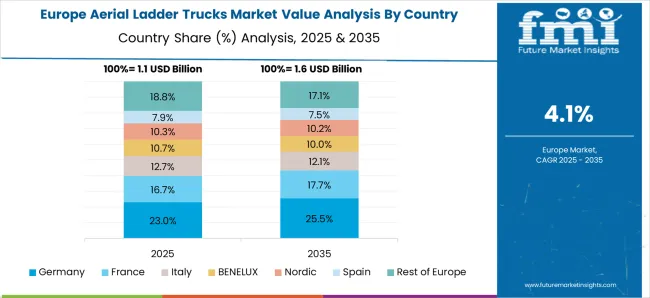
France is projected to experience a CAGR of 4.7% during 2025–2035, slightly above the global CAGR of 4.5%. Between 2020–2024, the CAGR was approximately 3.9%, with gradual adoption of advanced firefighting equipment driven by urban growth and stringent fire safety regulations. The market is expected to gain momentum in the next decade as France continues to invest in modernizing its firefighting fleets and improving rescue operations in urban and industrial areas. The need for more specialized equipment to access high-rise buildings and provide efficient fire suppression in densely populated regions will drive the demand for aerial ladder trucks. France’s strong focus on meeting EU fire safety standards and the expansion of infrastructure projects will further push the market’s growth.
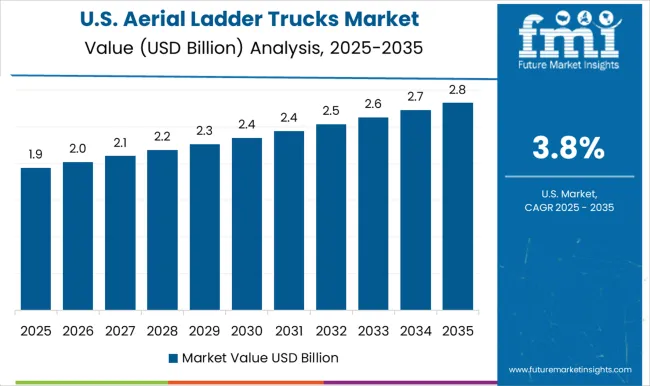
The USA is expected to achieve a CAGR of 3.8% during 2025–2035, slightly below the global CAGR of 4.5%. Between 2020–2024, the CAGR was around 3.3%, with the market largely driven by replacement demand and fire department fleet upgrades. The demand for aerial ladder trucks in the USA is fueled by the growing need to address fire safety in high-rise buildings and large industrial complexes. While growth is slower than in emerging markets, the focus on upgrading existing fleets and enhancing firefighting capabilities in urban environments will continue to drive the demand for these specialized trucks. The market is also influenced by advancements in safety features, operational efficiency, and equipment reliability.

The aerial ladder trucks market is highly competitive, with major firefighting equipment manufacturers driving innovations in safety, performance, and versatility. Darley, a key player, offers a wide range of aerial ladder trucks with a focus on customization, durability, and high-reach capabilities. E-ONE (Emergency One) is recognized for its advanced ladder systems and high-quality materials, catering to fire departments looking for reliable and efficient solutions. Magirus GmbH delivers a broad portfolio of aerial ladder trucks, known for their precise engineering and long-lasting performance, primarily for urban and industrial applications. Pierce Manufacturing Inc. is well-regarded for its innovative designs, focusing on providing modular, flexible aerial ladder trucks equipped with the latest safety technologies. REV Group Inc. offers specialized fire apparatus, including high-performance aerial ladder trucks, with a focus on enhancing firefighter safety and operational efficiency. Rosenbauer International AG stands out for its commitment to advanced firefighting technology and offers highly efficient aerial ladder trucks designed for high-reach operations in various environments. Smeal Fire Apparatus Co. provides high-quality, customizable firefighting vehicles, including aerial ladder trucks, aimed at optimizing fire and rescue operations. Spartan Emergency Response focuses on producing rugged and versatile aerial ladder trucks built to withstand the demands of modern firefighting. Competitive strategies in the market include investment in high-reach capabilities, advanced ladder control systems, and improved vehicle stability. Manufacturers differentiate themselves through customizable features, ergonomic designs, and enhanced safety components for urban and industrial firefighting. Strategic partnerships with fire departments, offering tailored solutions for both rescue operations and fire suppression, are key drivers of growth. As urban infrastructure grows and safety regulations tighten, aerial ladder trucks are becoming a critical component of modern firefighting fleets.
| Item | Value |
|---|---|
| Quantitative Units | USD 4.3 Billion |
| Product | Tower ladder, Turntable ladder, Hydraulic platform, and Tiller truck |
| Height | Low-Height (up to 50 meters), Mid-Height (50–100 meters), and High-Height (100+ meters) |
| Application | Fire fighting, Non-fire rescue operations, and Others |
| End-User Industry | Fire department, Municipal corporation, Industrial plants, Airports, and Others |
| Regions Covered | North America, Europe, Asia-Pacific, Latin America, Middle East & Africa |
| Country Covered | United States, Canada, Germany, France, United Kingdom, China, Japan, India, Brazil, South Africa |
| Key Companies Profiled | Darley, Eickhoff Corporation, E-ONE (Emergency One), Magirus GmbH, Metz Aerials, Pierce Manufacturing Inc., REV Group Inc., Rosenbauer International AG, Smeal Fire Apparatus Co., and Spartan Emergency Response |
| Additional Attributes | Dollar sales projections, market share by region and application (firefighting, rescue, etc.), growth trends in urban construction and emergency services, competitive landscape, and demand for high-performance trucks in high-rise areas. |
The global aerial ladder trucks market is estimated to be valued at USD 4.3 billion in 2025.
The market size for the aerial ladder trucks market is projected to reach USD 6.6 billion by 2035.
The aerial ladder trucks market is expected to grow at a 4.5% CAGR between 2025 and 2035.
The key product types in aerial ladder trucks market are tower ladder, turntable ladder, hydraulic platform and tiller truck.
In terms of height, low-height (up to 50 meters) segment to command 41.2% share in the aerial ladder trucks market in 2025.






Full Research Suite comprises of:
Market outlook & trends analysis
Interviews & case studies
Strategic recommendations
Vendor profiles & capabilities analysis
5-year forecasts
8 regions and 60+ country-level data splits
Market segment data splits
12 months of continuous data updates
DELIVERED AS:
PDF EXCEL ONLINE
Aerial Work Platforms Market Size and Share Forecast Outlook 2025 to 2035
Aerial Firefighting Market Size and Share Forecast Outlook 2025 to 2035
Competitive Overview of Aerial Imaging Market Share
Aerial Imaging Market Growth - Trends & Forecast 2025 to 2035
UK Aerial Imaging Market Trends – Demand, Innovations & Forecast 2025-2035
UK Aerial Work Platform Market Analysis – Size & Growth Forecast 2025-2035
USA Aerial Work Platform Market Insights – Demand, Size & Industry Trends 2025-2035
USA Aerial Imaging Market Analysis – Size & Industry Trends 2025-2035
BRICS Aerial Work Platforms Market Size and Share Forecast Outlook 2025 to 2035
Korea Aerial Work Platform MarketGrowth - Trends & Forecast 2025 to 2035
Japan Aerial Work Platform Market Growth – Innovations & Therapies 2025 to 2035
Japan Aerial Imaging Market Report – Trends & Innovations 2025-2035
ASEAN Aerial Work Platform Market Insights – Size, Trends & Forecast 2025-2035
Germany Aerial Imaging Market Analysis – Growth, Applications & Outlook 2025-2035
Germany Aerial Work Platform Market Trends – Demand & Outlook 2025-2035
Unmanned Aerial Vehicle Market Size and Share Forecast Outlook 2025 to 2035
Unmanned Aerial Vehicles (UAV) Commercial Drone Market Size and Share Forecast Outlook 2025 to 2035
GCC Countries Aerial Imaging Market Growth – Trends, Demand & Innovations 2025-2035
Western Europe aerial work platform market Analysis & Forecast by Product Type, End-use, Fuel Type, Platform Height, Sales Channel, and Region Through 2025 to 2035
Electrically-Driven Heavy-Duty Aerial Work Platforms Market Size and Share Forecast Outlook 2025 to 2035

Thank you!
You will receive an email from our Business Development Manager. Please be sure to check your SPAM/JUNK folder too.
Chat With
MaRIA